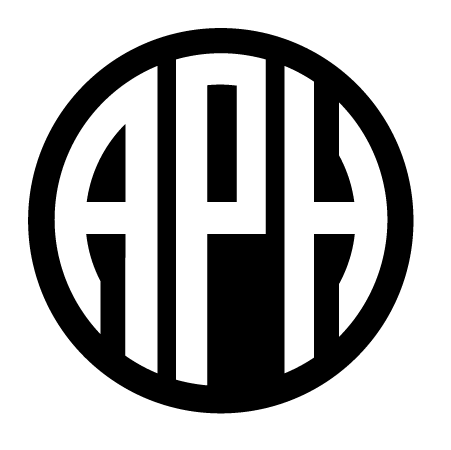APH News: November 2013
Your monthly link to the latest information on the products, services, and training opportunities from the American Printing House for the Blind.
Exciting New APH Products Announced!
Read on to learn about these new products – now available!
- APH Fall Harvest Sale
- New Downloadable Manuals Available
- NEW! Consumable Hundreds Chart
- NEW! Bold Line Tactile Graph Sheets
- APH Braille Book Corner
Hundreds Are STEMulated at APH Annual Meeting!
Please Visit our 145th Annual Meeting Photo Album
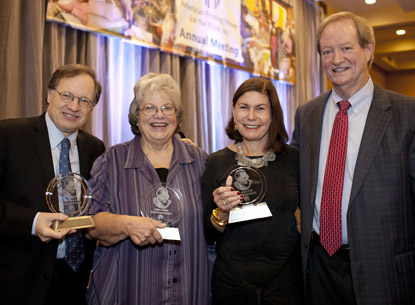
APH’s Tuck Tinsley (right) presented Zickel Awards during Friday morning’s General Session
Over 350 attendees reached out to touch the universe at their fingertips during the 145th Annual Meeting of Ex Officio Trustees and Special Guests of the American Printing House for the Blind October 17 – 19, 2013. Held at the Hyatt Regency in downtown Louisville, the event kicked off with an inspiring speech by keynote presenter Kevin O’Connor. Other highlights included concurrent sessions soliciting input on product ideas and initiatives, sessions that provided training on the use of new products, outstanding “Teacher Talks” in the Product Showcase, and an InSights Art Awards banquet and Hall of Fame Induction Ceremony that touched all who attended. APH staff presented new products, ideas, and projects in the well attended poster sessions, where the periodic table of the elements sugar cookies were a huge hit!
Virgil Zickel Awards, recognizing outstanding APH product ideas from the field, were presented to Texas Instruments (Orion TI-84), Ellen Trief and the Lavelle Fund (STACS) and to Millie Smith (SAM). APH was honored to present the Creative Use of Braille Award to the Ohio State School for the Blind Marching Band, which was accepted by band director Carol Agler and Superintendent Cynthia Johnson. A full slate of related meetings, activities for the 2013 APH Scholars, and mandated meetings for Ex Officio Trustees rounded out the event, which certainly STEMulated all who attended!
Make plans now to join us for the 2014 APH Annual Meeting at the Hyatt. It will take place October 16 – 18. We’ll see you there!
2013 Hall of Fame Induction Ceremony
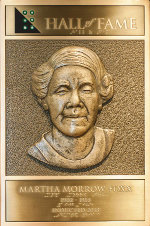
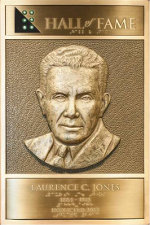
It was Friday evening, October 18, 2013, in Louisville, KY when the 51st and 52nd legends of the blindness field, Martha Morrow Foxx and Dr. Laurence C. Jones, were inducted into the Hall of Fame. The venue was the Hyatt Regency Hotel, and the event was a part of APH’s 145th Annual Meeting. The ceremony began with a video showing all 52 inductees immediately followed by Hall of Fame Curator Bob Brasher sharing a bit of the history and purpose of the Hall. From there, B.J. LeJeune, of Mississippi State, shared the evolution of the unique place of hope and learning in rural Mississippi that set the stage for our heroes—the Piney Woods Country Life School.
Dr. Rosie Pridgen then presented a spirited induction of Martha Morrow Foxx. And Napoleon Campbell, a former student, responded with heartfelt reflections of his teacher, Mrs. Foxx. The induction of Dr. Jones was deftly handled by B.J. with his grandson, Laurence C. Jones III, offering very special remembrances. Joining us for this unforgettable ceremony were Hall of Fame Inductees Alice Raftary (2002) and Dr. Richard Welsh (2008), 26 members of the Jones family, and student of Mrs. Foxx, Barbara Hadnott.
On that very special night, the Hall inducted and celebrated two courageous heroes who improved and changed the course of education and, in the process, immeasurably improved the lives of countless students and families. To be inspired by their achievements, please visit their Hall biography pages.
Consider making the Hall of Fame: Leaders and Legends of the Blindness Field, located at APH, a destination. Also, visit the Hall website for a virtual tour and the latest news!
2014 Hall of Fame Nominations Now Being Accepted
Who should be the next inductees in to the Hall of Fame for the Blindness Field?
If you are interested in learning more about the easy (electronic) process for submitting a nominee to join the 52 inductees, please visit: sites.aph.org/hall/nominate.
The nomination process will close Friday, March 28, 2014.
2013 National Prison Braille Forum
October 16, 2013
Hyatt Regency Downtown Louisville
APH Public Affairs staff was pleased to welcome 50 vision and corrections professionals from 16 states to Louisville for the 13th annual National Prison Braille Forum, which was held in conjunction with APH’s 145th Annual Meeting. Nine of the Forum participants were "alumni" of prison braille programs now working as independent transcribers.
Highlights of this day-long conference included an educational program, "Tactile Graphics—A Multi-Media Approach," which featured a video montage of teachers and students reading tactile graphics in the classrooms, followed by a panel of braille readers and teachers of the visually impaired critiquing tactile graphics and commenting on ways in which visuals can best be represented in tactile media. This program was recorded and will be sent to each Forum participant so it can be shared directly with transcribers in prison braille programs across the country.
Fran Wonders, who worked for many years as Director of the Michigan Braille Transcription Fund at Cotton Correctional Facility in Jackson, Michigan, was honored for her dedicated service providing millions of pages of braille to people with vision loss across the country, as well as giving hundreds of offenders the opportunity to learn braille, gain small business skills, and build new lives upon their release from prison. Fran is retired now and lives in Flagstaff, Arizona.
The "centerpiece" of the Forum each year is "across the country" reports from professionals in attendance, updating participants about their work with prison braille programs, or their experience as certified braille transcribers following release from prison. Several trends emerged from these reports:
- Strong relationships and partnerships between vision and corrections professionals and entities are key to the success of prison braille programs.
- There is a greater demand for braille materials now than ever before, and it seems to continually grow.
- Math textbooks—particularly higher math—are by far the most requested educational materials for braille transcription. They take much time to produce and require advanced certifications and experience by transcribers.
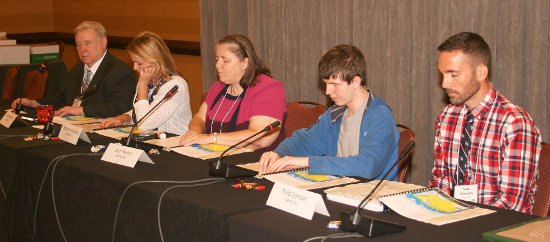
Attendees at the 2013 National Prison Braille Forum received useful feedback about the readability of tactile graphics directly from members of a panel of vision teachers and braille readers.
APH Named Kentucky’s 2013 Mid-Sized Manufacturer of the Year
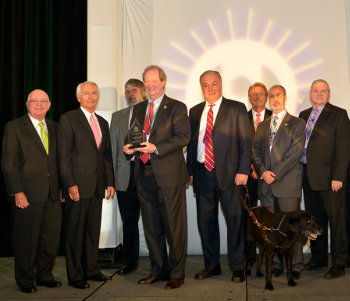
Greg Higdon (KAM), Kentucky Governor Steve Beshear, Frank Hayden, Dr. Tuck Tinsley, Judge David Holton II, Bill Beavin, Mustapha Debbabi, and Jack Decker
On Friday, October 4, 2013, APH was honored by the Kentucky Association of Manufacturers (KAM) as the 2013 Mid-Size Manufacturer of the Year in the Commonwealth of Kentucky.
The nomination process included a 4-page essay written by APH’s Frank Hayden (Technical Research) and submitted by Roberta Williams (Public Affairs). The essay addressed the three main criteria used to select the winning companies: innovation with regard to products, production methods, and services; corporate citizenship within the community and the Commonwealth; and support of industry and manufacturing.
In his opening remarks KAM President & CEO Greg Higdon stated, “These awards pay tribute to those from our manufacturing community who provide leadership, demonstrate high standards, and promote manufacturing here in the Commonwealth, and these winners embody all of those traits. It is an honor to be nominated for these awards, and this year, we had a record number of nominees, making our selection committee’s job even more difficult than usual. We congratulate all of our nominees, and our 2013 winners.”
Kentucky Governor Steve Beshear keynoted the luncheon and presented awards to Lectrodryer, LLC, winner in the small business category; APH in the mid-sized business category; and General Motor’s Corvette Assembly Plant in Bowling Green in the large business category.
Each winner was introduced using a video of information about the winning company. Here is the video about APH: www.youtube.com/watch?v=bHLoC4bKY-o.
NEEDED: Input on Use of Refreshable Braille Displays
In order to help ensure that online test items are accessible via commonly used refreshable braille displays (RBDs), APH’s Accessible Tests Department is gathering information about the use of RBDs by students and clients with visual impairments.
Access the Refreshable Braille Survey at https://www.surveymonkey.com/s/PJ6G9P7 and respond online, if possible. If this is not possible and you wish to respond, please call Debbie Willis between 11:00 a.m.—5:00 p.m. ET at 800/223-1839, ext. 311, and she will be happy to record your input. Feedback will be collected November 4-22, 2013. Thank you in advance for your time and expertise in providing valuable input to this survey of student/client use of refreshable braille displays! Survey results will be made available at archive.aph.org on the Accessible Tests webpage.
Treasures From the APH Libraries
Subject: Abraham Nemeth

Dr. Nemeth at his Hall of Fame Induction, 2005
The APH Barr Library supports research initiatives at APH, while the Migel Library is one of the largest collections of nonmedical information related to blindness in the world. Although the collections do not circulate, arrangements can be made to use the materials on-site. In addition, an ongoing digitization effort means APH will continue to make materials available through the online catalog at http://migel.aph.org.
From the Migel Library: Nemeth, Abraham. "Recent Developments in Computerized Mathematical Braille." Proceedings. Conference on New Processes for Braille Manufacture, American Printing House for the Blind, Louisville. Center for Sensory Aids Evaluation and Development, MIT, 1968.
Although he had not actually been working in the field of computerized mathematical braille at the time of the Conference, Dr. Abraham Nemeth suggested that computer implementation of the Nemeth Code could be a very natural progression. He related a personal story about the earliest development of the Nemeth Code. While studying math in college, he said, his wife would read problems aloud to him. To write these problems down, he developed a set of shorthand braille symbols that became known in the Nemeth Code as the “indicators.” New computerized keypunches, he believed, could be developed easily for these expressions. The work already done on literary braille would be of even further help to the progression, he said. He presented some examples of helpful literary braille work in the Proceedings, which have been digitized for access at http://archive.org/details/conferenceonnewp00unse.
From the Barr Library: Kapperman, Gaylen, Toni Heinze and Jodi Sticken. "Introduction." Strategies for Developing Mathematics Skills in Students Who Use Braille. Sycamore, IL: Research and Development Institute, Inc., 1997. 1-10.
The Introduction begins with a discussion of the visual nature of concepts and limited experience with Nemeth Code as barriers to math students who are blind. The authors name APH as a critical component to success, due to their production of materials for math instruction for the blind. Included in the discussion is a notable response by Dr. Abraham Nemeth, in which he describes the factors that supported his achievements as a mathematician. Although he did not require any special instructional techniques, he believed that current educators could learn from the failures of his own teachers, and stated, “I often wished that my instructor would verbalize what he was writing on the blackboard… I could not have reached my potential in mathematics without the Nemeth Code. With it, I am able to read and write mathematics, as well as other sciences, at all levels, limited only by my talent and ambition.”
APH is working with the LYRASIS Consortium and Internet Archive to digitize portions of the M.C. Migel Library. Search the phrase “full text” to find these items at http://migel.aph.org. The digitized texts are available in a variety of formats, including DAISY, Kindle, EPUB, PDF, etc.
Contact Library staff: library@aph.org, 800-223-1839, ext. 705
APH Participates with Publishers on EPUB 3 Project
Julia Myers, Nicole Gaines, and Larry Skutchan participated in the Association of American Publishers (AAP) EPUB 3 Implementation Project meeting on September 10th at the Random House Tower in NYC. The Project was composed of various work streams charged with identifying best practices for EPUB 3 in the areas of features, accessibility, and metadata. The event in NYC brought the results of the various work streams together in a workshop for publishers, reading systems providers, and the accessibility community.
The goal of the EPUB 3 Implementation Project was "to accelerate the across-the-board adoption of the EPUB 3 format in the consumer market by identifying and implementing what stakeholders consider to be the core set of baseline features critical to the format’s acceptance. Among these features are greater interactivity for users, multimedia-enhanced content and expanded accessibility for people who are blind or have other print disabilities." (Source: http://publishers.org/epub3implementationproject/ (archival))
EPUB 3 is a new eBook format that holds promise to revolutionize the eBook reading experience through its support of interactivity and inclusion of media content directly in the "book." At the same time, these new features and content will involve changes both in how publishers create eBooks, and how reading systems work to read them.
APH recognizes that EPUB 3 has profound implications for accessibility and was pleased that the workshop was well attended by other accessibility advocates, publishers, and reading system manufacturers. The participation of the accessibility community in the EPUB 3 Implementation Project has provided an opportunity to give voice to important concerns and ensure that accessibility is front and center in EPUB 3 best practices priorities. Many of the accessibility principles incorporated in EPUB 3 have been in the works for years and tirelessly supported by advocacy and industry groups such as the International Digital Publishing Forum, the DAISY Consortium, and others.
From the braille perspective, one of the most important optional accessibility features of EPUB 3 is the inclusion of MathML. MathML makes it possible to automatically convert math into Nemeth Code, the braille code for mathematics. Other accessibility best practices discussed include providing descriptions for images, separating content from style, and using the accurate structures and tags within a title so that content can be rendered correctly in an accessible format.
Another important aspect of EPUB 3 is the implementation of good metadata practices. A title’s level of accessibility needs to be made known to the potential user, so when a consumer who is blind considers purchasing a book, he or she can tell if that book conforms to the accessibility standards expected. This gives the individual confidence that the book is accessible.
Julia Myers and Larry Skutchan led the Accessibility Work Stream and several APH staff from Research, Resource Services, and NIMAC have participated actively in the discussions and work of the project. The EPUB 3 Implementation Project White Paper is now publicly available via AAP’s website at http://publishers.org/news/epub-3-implementation-project-white-paper-now-online
Oldies but Goodies: The "Established" APH Product Series
Sound discrimination is important for traveling safely, identifying people, literacy, communication, and so forth. It is important to teach children to make use of environmental noises to enrich their lives. Auditory skills development, just like visual skills development, requires well-thought-out instruction that is provided regularly and consistently. The Sound Matching Boards I & II are tools available from APH to assist in developing this skill.

Sound Matching Board I

Sound Matching Board II
Sound Matching Board I includes 12 cylinders (four loud and eight soft-sounding) and a circular, 12-hole board. This product develops fine motor skills and auditory matching and discrimination, with the capability of introducing sequential order. It can also be used to teach the concepts of circle, outer edge, center, in, out, clockwise, and counter-clockwise.
Sound Matching Board II includes eight shakers of four different sounds, and an 8-nest base. This product helps develop concepts of a series, directions, positions, matching, and discrimination. It can be used to reinforce the concepts such as left, right, bottom, top, horizontal, vertical, rows, pairs matching, etc.
If you have any suggestions for other products you would like to see highlighted in this monthly feature, please send your comments to Monica Turner at mmturner@aph.org.
APH Product Alerts:
FREE: New Firmware Update for the Braille Plus 18!

A new version of firmware for the Braille Plus 18 is available.
To upgrade, connect to a Wi-Fi hotspot. Your unit will receive a notification about Braille Plus 18 software updates available. Tap that notification to start the update process. Once the software downloads, it will issue another notification. Tap the notification that says, "Install Update." Your unit will reboot and install the new software.
For a list of new features, see: http://tech.aph.org/plus_new.htm
FREE Update: New Version of Nearby Explorer, the Android GPS App!

This update includes the following features:
- Uses the new-style More Options button for access to the menu, making all menu options available in one list when running on Honeycomb and later
- Corrects many issues with guidance and rerouting
- Runs routing for guidance in the background so the app does not appear to hang when generating long routes
- Disables unused options in the Route Options settings screen when Pedestrian Mode is active
- Improves display update handling to work around accessibility differences in Android 4.3
- Improves external address handling when using Nearby Explorer from another app to get directions
- Adds the "R" command to directly open Route Settings on devices with keyboards
- Fixes an occasional crash when using Google for street addresses
- Fixes a crash when running with self-voicing turned off
If you purchased Nearby Explorer from the Play Store, your device will automatically update. If you purchased directly from APH with quota funds, download the following to update the version on your device: http://beta.aph.org/ne_beta.apk
Around the House:
APH Going Greener
Starting in the spring of 2014, the grounds of APH will be greener, and it’s not because of petroleum based nitrogen fertilizers being applied to our lawn. The facilities maintenance team has selected to work with a locally owned business that is committed to environmental stewardship. Limbwalker Tree Service provides an organic-based lawn care program that will not only keep our lawn looking its best, but will improve the quality of the soil to support the health and growth of the lawn, shrubs, and trees. http://www.limbwalkertree.com/
APH Development Department
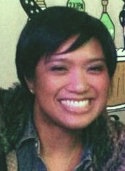
Chona Camomot recently joined APH as the Development Coordinator after serving as Office Manager at M&J Properties of Kentucky. Chona holds a Masters in Broadcasting from Boston’s Emerson College and a Bachelors in Journalism from Indiana University. Welcome!
From the Field:
American Institutes for Research Initiates Certification Program for Devices and Assistive Technology that Work as Intended for Test Taking
The American Institutes for Research (AIR) is administering online assessments to students in states that are members of the Smarter Balanced Assessment Consortium (SBAC). The online assessments will address issues related to visual, auditory, and physical access barriers, as well as the specific needs of test takers with limited English proficiency. Addressing these concerns will enable virtually all students to demonstrate what they know and can do. AIR’s online testing system uses computer adaptive testing technology (i.e., a system whereby each test taker receives an individually tailored set of items and tasks) to empower students, their families, teachers, administrators, and communities with meaningful data and feedback to enhance the test takers’ learning processes. For additional information regarding SBAC’s goal to support under-represented students, go to http://www.smarterbalanced.org/parents-students/support-for-under-represented-students/
Accessibility is a core principle of the SBAC development process. In order to promote accessibility and the use of technology that works as intended or stated for test takers, AIR has developed a Certification Program for providers of devices and assistive technology. The site is available to the public. However, since there is a small fee for certification along with extensive technical information required, the intent is that manufacturers of various devices will submit for their certifications, not states, districts, or schools. If a particular device or assistive technology works as intended for test takers during assessments, then AIR will certify the product and add it to a list of devices and assistive technology that anyone in the general public may access. For more information, visit http://certification.airast.org/
BANA’S UEB Transition Forum Brings Braille Leaders Together to Plan
Planning for the implementation of Unified English Braille (UEB) took a huge step forward on Wednesday, October 16, when the Braille Authority of North America convened 48 delegates representing 31 organizations from the braille community in a UEB Transition Forum. Held Louisville, KY, preceding the APH Annual Meeting, the Forum was a full day of collaborative planning designed to help delegates and their representative organizations determine the steps and timetable through which the United States will make an effective transition to Unified English Braille.
The Forum, organized and facilitated by BANA, provided the rare opportunity for delegates from various braille-related communities to meet face-to-face. The ambitious agenda focused on identifying specific actions and strategies required to develop plans for a smooth and effective implementation of UEB.
Forum planners recognize that the transition plan must take into consideration all aspects of using, learning, teaching, and producing braille. With that as a guiding principle, the Forum was organized into facilitated workgroups through which Forum delegates identified and prioritized actions needed in the following areas:
- quality UEB training for transcribers, proofreaders, and educators;
- the building of UEB transcription capacity;
- system adjustments for the procurement and delivery of braille materials in UEB;
- a smooth transition to UEB for children’s braille reading and writing instruction and educational assessments;
- a smooth transition of adults’ braille instruction to UEB and increased knowledge of UEB among adults who already use braille.
The delegates to the Forum acknowledged that the transition to UEB will take time as well as extensive preparation and collaboration among all the systems and infrastructures involved. Their work on October 16 laid a foundation that will help leaders build a carefully crafted timeline and coordinated plan. Detailed timelines are under development by individual organizations, and transition efforts are now being initiated. The consensus of the delegates was that January 2016 is a reasonable target date for the implementation of UEB. The work accomplished at the Forum will assist the braille community as it builds and adapts the infrastructure necessary to meet the proposed implementation date.
BANA’s UEB Task Force as well as the BANA Board will meet in early November in Louisville. At this meeting, they will discuss the transition to UEB with the goal of setting a definite implementation date, which will then be formally announced.
For additional resources and information, visit www.brailleauthority.org.
APH on the Road
Indiana Vision Expo, 2013
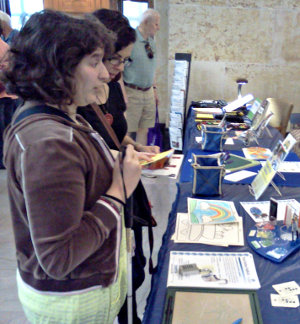
Kerry Isham, APH Field Services Representative, was on hand at the Indiana Vision Expo on September 28th at the State Library in Indianapolis. This event is the Midwest’s largest trade show for consumers who are blind and visually impaired. Approximately 400 professionals in the field of blindness and visual impairment, individuals with vision loss, and their friends and families were in attendance, showing particular interest in such APH products as the DRAFTSMAN Tactile Drawing Board, the Lighting Guide Kit, Paint Pot Palette, Picture Maker, Touch ‘em All Baseball, and the Sherlock Talking Label Identifier. Thank you, Indiana, for providing us this wonderful opportunity to get the word out about our products!
North to Wisconsin!
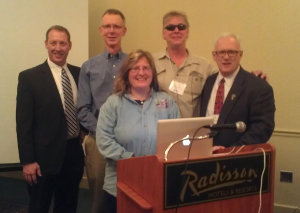
Pete Dally, Director of WI Center for the Blind & Visually Impaired Marshall Flax, WI Council of the Blind & Visually Impaired Julie Hapeman, President of WAER, Larry Skutchan, & Ralph Bartley
APH headed north to participate in the Wisconsin AER’s 2013 Annual Conference in Wauwatosa, October 24-25. Monica Turner, Field Services Representative, presented a brief overview of several new APH products including Book Port DT, Braille Plus 18, Orion TI-84 Plus Talking Graphing Calculator, and Tactile Town. She also exhibited these products—and more—the following day. Larry Skutchan, Technology Project Leader, informed the group about Nearby Explorer which is APH’s new full featured Android GPS application.
APH at 2013 Louisiana Fall Conference
Kerry Isham of Field Services, represented APH at the Louisiana Fall Conference held in Ruston, LA from September 20th through 22nd. The conference drew approximately sixty attendees, many of whom made it a point to stop by the APH booth to try out products such as The Best for a Nest, Tactile Town, the Getting to Know You Kit, Giant Textured Beads with Pattern-Matching Cards, and the APH Intervention Continuum (Sensory Learning Kit, SAM, and Tactile Connections). On the second day of the event, along with the exhibit, Kerry held “APH Theater” showing a brief video on APH and our products and serving popcorn! The conference was a wonderful opportunity for networking and learning, and APH was excited to be a part of it.
Amazing Pitt Stone
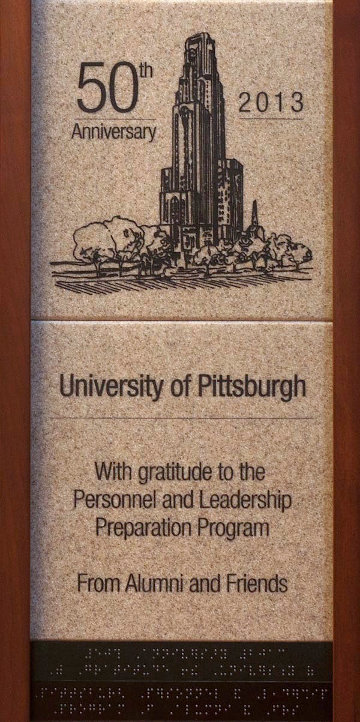
This stunning stone display was installed recently on the Wall of Tribute in the Hall of Fame. The donation campaign is well on the way. If you feel a connection to the University of Pittsburgh program and wish to add your name to the list of contributors, it is a simple two-step process. Simply click the link for a Hall of Fame donation and make your contribution (no, you do not need to be a member of PayPal). Follow-up your donation with an email to the Hall (halloffame@aph.org) indicating the stone you wish to help sponsor.
Repair Source for the MaximEyes
Is your old video magnifier MaximEyes in need of repair? Here is a good source, according to one of our trusted Ex Officio Trustees! ($95.00 for analyzing, but cost is applied against the final invoice.)
ABL Electronics
314 E. 14 Mile Rd.
Madison Heights, MI 48701
248-588-6663
Contact: Al
Email: ABL BURK@aol.com
Two New Videos: Braille Plus 18 Speech & Braille Preferences and Talking Graphing Calculator Speech & Help Options
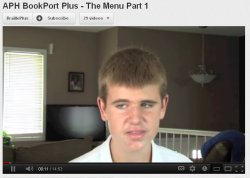
Student Chase Crispin and his teacher LeAnna MacDonald have created two new videos on APH products: the first covers speech and braille preferences dialog of the Braille Plus 18. The second video discusses the speech and help options of the Orion TI-84 Plus Talking Graphing Calculator. Find these new videos on our products video page. Thanks again to Chase and LeAnna for creating many helpful videos!
Social Media Spotlight

Judge David Holton playing guitar and singing My Old Kentucky Home
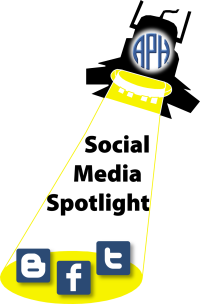
Tuesday, October 15 was White Cane Safety Day, part of National Blindness and Visual Impairments Awareness Month. APH, along with other organizations in the community, participated in Louisville’s White Cane Safety Day events downtown. One of our Board members, Judge David Holton, was awarded the Rider-Shaw Award, which recognizes a visually impaired citizen that has made a significant contribution to the community. (from the APH Facebook page)
"Like" APH at Our Facebook Page!

We invite you to visit our Facebook page and "Like" us! You can find APH at these social media sites: Twitter, YouTube, Flickr, and at our blog, Fred’s Head from APH.
APH Welcomes New Ex Officio Trustees
William Tubilleja, the North Carolina Department of Public Instruction, PNP account, replacing Julie Kagy.
Brian Darcy, the Idaho School for the Deaf and the Blind and the Idaho State Department of Education, replacing Robin Swenson.
Catherine Golding, the Criss Cole Rehabilitation Center, replacing Charles Atwell.
APH Travel Calendar

December
December 4-8, 2013
Getting In Touch With Literacy Conference 2013
December 5-6, 2013
NIP Event: Cortical Visual Impairment;
Grand Forks, ND
December 11-14, 2013
AER International: All-Orientation & Mobility Conference 2013;
New Orleans, LA
December 13, 2013
VRATE-17th Annual Vision Rehabilitation & Assistive Technology Expo;
Phoenix, AZ
January
January 29-February 1, 2014
ATIA 2014 (booth #800);
Orlando, FL
February
No travel at this time.
March
March 12-14, 2013
KAER 2014 State Conference;
Lexington, KY
March 18-22, 2014
AAHPERD 2014;
St. Louis, MO
March 17-22, 2014
CSUN 2014 (booth #700);
San Diego, CA
APH Fall Harvest Sale
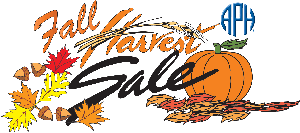
Load up a world of savings on selected APH products with APH’s Fall Harvest Sale 2013, October 1—December 31. As always, first come, first served.
New Downloadable Manuals Available
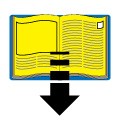
Get the manual you need instantly! APH offers a selected list of product manuals available for free download (archive.aph.org/manuals/). You may print or emboss these as needed. We will continue to package hard copies of these manuals with their products and sell hard copy replacements.
Newly added manuals include:
- Consumable Hundreds Chart Guidebook
- Power Select Instruction books in both English and Spanish
NEW! Consumable Hundreds Chart
5-82710-00 — $15.00
Related Product
Hundreds Boards and Manipulatives: 1-03105-00 — $140.00

APH’s Consumable Hundreds Chart is a graphic organizer for the numbers 1–100. Working with the Hundreds Chart helps learners develop the skills they need to become flexible and fluent problem solvers and meet the requirements of many state standards as well as the Common Core State Standards.
The chart is printed/embossed on heavy white index stock paper. Alternating rows are highlighted to help students with low vision easily track numbers. Five sheets have no highlighting so students can easily color or mark numbers and patterns.
Includes
- 10 charts: 5 with highlighting, 5 without highlighting
- Guidebook, large print
The Consumable Hundreds Chart Guidebook is available as a free download in accessible formats of .brf and .txt from the APH website: archive.aph.org/manuals/
NEW! Bold Line Tactile Graph Sheets
1-04080-00 — $21.00

An ideal tool to help teachers and transcribers create charts and graphs for students who are blind and visually impaired. Bold Line Tactile Graph Sheets combine tactile and print, which expand APH’s graph sheet collection previously available only on embossed paper or print-only paper. Label and embellish these graph sheets using a variety of methods (e.g. braillewriter, line-embossing tools, glued-on or adhesive-backed textured paper or foam, tactile stickers, graphic art tape, etc.).
50-pack Bold-Line Tactile Graph Sheets, 1/2 inch squares in a 15 x 20 inch grid for bar graphs, on 100 lb. white text stock.
APH offers a number of recreational books in braille (Quota funds can be used). Each of these titles was originally transcribed and produced by APH for the National Library Service which has graciously granted permission for this offering. As usual, these titles have been added to the APH Louis Database where you can find thousands of titles produced in accessible formats.
Note: all books are produced upon receipt of orders, therefore, please allow several weeks for delivery.
A Really Short History of Nearly Everything
by Bill Bryson: T-N1886-20 — $57.00
Explores the mysteries of time and space including the Big Bang to explain the arrival of life on planet Earth. Discusses scientists and their discoveries, fossils, chemistry, the Earth’s bulge and size, plate tectonics, bacteria, trilobites, asteroids, human species, and future possibilities for our world. Grades 3-7.
A Life Like Mine: How Children Live Around the World
by Dorling Kindersley Publishing et al: T-N1886-00 — $26.00
Introduces children of various nationalities and backgrounds who share the desire for a healthy, safe place to grow up. Discusses children’s basic needs for food, water, shelter, schooling, and play. Describes the issues of war, disabilities, and child labor. Grades 5-7.
The Pampered Chef: The Story of One of America’s Most Beloved Companies
by Doris Christopher: T-N1870-70 — $70.00
A stay-at-home mom describes starting a small kitchen-tool business from the basement of her home and growing the company into a billion-dollar corporation ultimately purchased by Warren Buffett. Discusses her family’s commitment to the business and reveals the challenges associated with its expansion. Offers strategies to help start-up entrepreneurs.
Miss Julia Rocks the Cradle
by Ann B. Ross: T-N1938-60 — $88.00
During a blizzard, elderly Miss Julia helps deliver Hazel Marie’s twin babies. When a dead body is found in a neighbor’s toolshed, Miss Julia investigates. She also searches for the person who has been writing bad checks in her name.
In the Company of Others: A Father Tim Novel
by Jan Karon: T-N1918-20 — $124.00
Retired Episcopalian priest Father Tim takes his wife Cynthia on vacation to his homeland of Ireland. During their stay at a fishing lodge run by Anna and Liam Conor, Father Tim becomes overly involved in the extended Conor family’s problems and Cynthia discovers a journal from the 1860s.
*Accelerated Reader quiz number, book level, and point value. For more information on the Accelerated Reader program, see the January 2006 APH News or www.renlearn.com/ar/
APH News Credits
President:
Dr. Tuck Tinsley
ttinsley@aph.org
Designer:
Malcolm Turner, APH Website Coordinator
webmaster@aph.org
Thanks to the following APH staff:
- Cindy Amback, Support Specialist, Field Services
- Janie Blome, Director, Field Services
- Scott Blome, Director, Communications
- Kerry Isham, Field Services Representative
- Justin Gardner, Special Collections Librarian, Resource Services
- Frank Hayden, Technical Research Manager, Research
- Stephanie Lancaster, Graphic Designer, Communications
- Drew Lueken, Support Specialist, Communications
- Mary Nelle McLennan, APH Representative to BANA
- Julia Myers, Director, Resource Services
- Artina Paris-Jones, Assistant, Field Services
- Anita Rutledge, Facilities Supervisor
- Larry Skutchan, Manager, Technology Products
- Monica Turner, Field Services Representative
- Debbie Willis, Director, Accessible Tests
Editor:
Bob Brasher, Vice President, Advisory Services and Research
bbrasher@aph.org
Read our blog: Fred’s Head from APH.
For additional recent APH News, click the following:
October Issue – archive.aph.org/news/october-2013
September Issue – archive.aph.org/news/september-2013
August Issue – archive.aph.org/news/august-2013
Archive of all previous issues – archive.aph.org/news/archive
The APH News is a monthly publication from the American Printing House for the Blind:
1839 Frankfort Avenue
Louisville, KY 40206
800/223-1839
Please share this web link or any items that appear in this publication with anyone who might benefit.
Thank you.
Subscribe to the APH News!
Get convenient email reminders every month when a new issue of the APH News is released.
It’s Easy!
- Create an email to aphinfo-request@iglou.com
- Leave the subject blank
- Type the word ‘subscribe’ (without any quote marks) in the body of the message
- Send it.


